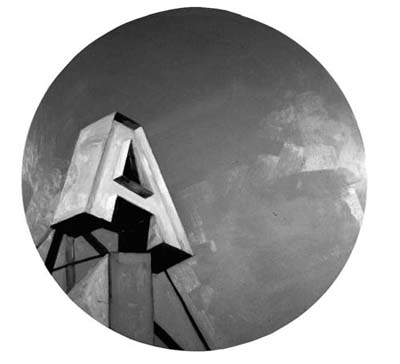
REVIEW
Tondos: New Paintings of Modest Landmarks
Bill Gross
Aron Packer Gallery, 118 N. Peoria
www.aronpacker.com
Through February 9
Signs of the Times 
By Laura Thompson
If you live high up in some loft on the West Side of Chicago and see someone across the street peering out of his window with a telescope, don't be so quick to assume it's some sinister, Sliver-style voyeur. It's probably just Bill Gross in his studio - and he's merely appreciating the vernacular architecture, or, as he puts it, "modest landmarks."
Begun in 1993, Bill Gross' "tondos" (a word that to refers to round paintings or similar works of art) depict fragments of vintage signs on the west side of the city, probably dating from the 1950s and 1960s, that read, for example, CAR WASH, PARK or LIQUORS. In each case, the entire sign is not visible - only a fragment is shown, excised from its environment by Gross' telescope-like view. The paintings themselves are often pleasingly layered with strokes of thick paint. But this textural quality is interestingly countered by the eerily smooth surface that characterizes the buildings in the work. Everything may seem too smooth �too perfect. There is no dirt or smog or cracks in the walls. Gross edits out most of the faults in the sharply executed signs, and blurs over the imperfections in the buildings and street signs in the background. In this sense, Gross' selective eye and painting style share similarities with the stark, soft-focus work of Edward Hopper.
0The round shape of his works evokes the sense that some sort of lens-based device played a part in their making - such as a telescope or a camera, and, indeed, they possess an appealing and striking photographic sensibility. The fragmented quality of Gross' views echoes the process of photographing: looking through the viewfinder, cropping and isolating an object or scene. The result fragments the buildings, poles and windows, turning them into abstract shapes. And, further, his paintings have a shallow "depth of field": the signs in the foreground are sharply rendered with utmost precision, while the buildings and telephone wires in the background grow fuzzy and more painterly against a blue sky. As a whole, they speak strongly to the irreversible impact that
photography has had on painting.

The Gestalt principle of closure is inherent in Gross' work. The principle describes, among other things, our ability to fill in missing information when necessary, in order to "see" and understand a whole. In Gross' paintings, even though an entire sign is never shown, we still know what it says. These bold, visual instructions are familiar and practical parts of city architecture, instructing us from afar where to buy booze or, at a moment's notice, where to park. One of Gross' paintings depicts a chunky, white letter P next to an arrow that points straight down, jutting out against a puffy cloud and blue sky. Despite Gross' abstraction of the sign, there is little doubt in the mind of the viewer that the sign reads PARK. Another more challenging example is a series of four small, simply painted tondos which together partially spell CAR WASH, even though only the top corners of each letter are depicted. Strange and quite abstract at first, after a moment the words become clear.
Gross' artist's statement notes that the signs he paints "are frequently disintegrating and ultimately disappearing, underscoring a sense of loss that is in contrast to a sky that provides a reassuring sense of continuity." Reflecting this idea is the subdued, underlying sense of nostalgia in the work. The viewer instantly recognizes these signs as old (duplicated on occasion today to achieve a retro appeal, � la Clark Street's Salt & Pepper Diner). They are characterized by whimsical and enthusiastic curved arrows and colorful bulb-lit letters. Gross brings recognition to this fading aesthetic, recording it in the way a documentary photographer might, bringing to mind Bernd and Hilla Becher's project to document the obsolete, broken architecture of the industrial age that often grows more interesting as it crumbles. Gross' eye is attracted to dated objects and his statement affirms his interest in "the transitory nature of our urban landscape." Probably all too soon will his paintings become peepholes into the past, and remnants of an extinct aesthetic.
Images of tondos courtesy of Bill Gross.
|

